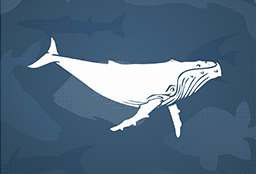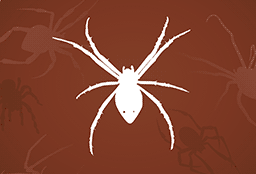Large solid marine snail (mollusc) with noticeable rounded spirals (whorls). Generally smooth but some individuals show 2 strongly developed rows of spines on the body; rown or dark green striped patterns on a lighter green/fawn background.
They are fished commercially for human consumption. They are also prized bait for fisherman and can be locally fished out in some areas.
Its species name banksii is after the English naturalist and botanist Sir Joseph Banks.
A small, brown seaweed (algae) which resembles a beaded necklace. It has branches (thalli) which are made up of strings of hollow, water-filled, round or oval-shaped beads joined together by a short stalk. Each bead is covered in many pores, giving it a rough surface. It is attached to the substrate by a thin disc (holdfast).
Size
Fronds 10 – 30 cm long, beads 5 – 15 mm in diameter, and holdfast 3 – 10 mm across.
Mostly black in colour with a light grey saddle behind the dorsal fin and a distinct white oval shaped horizontal patch behind the eye. The belly, underside of the jaw, and underside of the tail are also white. Mature males have a tall triangular-shaped dorsal fin while females and juveniles have a smaller, more curved dorsal fin.
Size
Adults reach a length of 10 m, dorsal fin up to 1.8 m in height.
Black and white, with the pattern varying across its range. The back of its neck, upper tail and shoulders (on its wings) are white in males and grey in females, and (across most of Australia) the rest of its body is black. In south-eastern, central and south-western Australia, including Tasmania, its back and rump are entirely white. Its eye is red-brown. Young birds are usually grey rather than black and have dark eyes.
Distinctive feature
One toe faces backwards and three face forwards. It has a square-tipped tail.
A medium-sized marine snail (mollusc). They are grey or off-white in colour, with 5 - 6 distinctive ridges spiralling up towards a sharp tip (apex).
Size
25 - 50 mm
Field Guide
Improve your identification skills. Download your Ribbed Top Shell guide here!
A tussock-like, rosette plant. Tussock size up to 30 cm high and wide with a flower stalk up to 1 m high.
Leaves
Long, sword-shaped and forming a clump. Each individual leaf is 8 – 20 cm long and 1 – 3 cm wide and usually stands upright. There are 5 veins running down each leaf.
Flowers
Small and initially cream, but turn brown rapidly. They grow on top of a ridged, 1 m high flower stem growing from the centre of the tussock of leaves. The flowers form a tight, cylindrical cluster which is 1 – 7 cm long.
Named in 1830 by explorer and botanist, Allan Cunningham. The genus name Grevillea honours Charles F Greville who co-founded the Royal Horticultural Society, and the species name robusta refers to its large size.
Evergreen tree usually grows 20 – 30 m tall but can range from 8 – 40 m in height.
Leaves
Silvery green and fern-like, green on the upper surface and paler underneath. They are 10 – 34 cm long and 9 – 15 cm wide, and consist of 11 – 31 segments that are narrow-elliptic to triangular in shape. The segments are 1.5 – 5 cm long and 2 – 10 mm wide, and they give the leaf a deeply divided appearance.
Flowers
Golden yellow to orange, each one is about 2 cm long but they are arranged in pairs along the flowering stalk to give an overall length of 12 – 15 cm.
The name ‘right whale’ was given to them by early European whalers who thought they were the ‘right’ type of whale to hunt. Their slow moving nature made them easy targets and their blubber was of high quality. They also floated when dead, making them much easier to move to shore.
Generally black with small patches of white on the belly and lacking a dorsal fin. They have a rounded head and short, spatula shaped flippers with a distinctive V shaped blow.
Distinctive feature
They have numerous, pale coloured callosities around the head.
This spider is named for the cross the female weaves into the web. There are many theories about why the female does this including, strengthening the web, for camouflage, and for increasing prey catches as the cross reflects ultra-violet light which attracts insects. It may also deter predators which must go to the effort of cleaning off the extra silk after diving into the web.
The female has a silvery head with silver, yellow, red and black bands across its abdomen, and two yellow stripes running down its underside. Its legs are dark brown to black with one or two yellowish bands. The male and juveniles are brown and cream, with brown legs. It often appears to have only four legs because it sits with its legs in pairs along the stabilimentum.
Distinctive feature
The zigzag patterns (known as the stabilimentum) it weaves into its web to form an X or a cross, after which it is named.
The striped marsh frog or brown-striped frog is a common species in urban habitats It is a mostly aquatic frog native to coastal Eastern Australia.
A pale to grey-brown back with darker brown stripes. Usually also a pale stripe running down the middle of its back. Its belly is white and often flecked with brown, and there are dark spots and stripes on its limbs.
Size
4.5 - 7.5 cm
They are called Surf Barnacles because they prefer to live in areas of medium to high energy wave action.
Small invertebrates that live inside hard circular or pyramid-like structures made from calcium-carbonate. They have eight main side plates, surrounded by many smaller ones, giving them a scaly appearance and are usually grey with a greenish tinge.
Size
20 mm high, 25-30 mm diameter.
Field Guide
Improve your identification skills. Download your Surf Barnacle guide here!
A small green seaweed. It has dark round, forked fronds (branches) with a fuzzy appearance and a velvety or sponged texture.
Size
Up to 30 cm long.
Field Guide
Improve your identification skills. Download your Velvet Weed guide here!
Medium marine snails (molluscs) that float around in the open ocean. They have a purple shell that lightens in colour as you move towards the flattened top of the shell. The shell itself is very light weight and they have no operculum (lid). Their flesh is a dark purple or sometime black.
They float around the open oceans upside down, attached to a raft of mucus bubbles that they make.
Size
Up to 30 mm
Flower-like invertebrate that has many long tentacles surrounding a central mouthpart which is attached to a hard surface. These specialised fighting tentacles come from the acontia, which appear as white spots on the top of the column. At low tide or when disturbed, the tentacles retract and the anemone looks like a round blob of jelly. They range in colour from bright red, reddish-brown to dark purple.
Their tentacles contain hundreds of stinging cells called ‘nematocysts’ which the anemone uses to sting and immobilize their prey, and to do battle with other unrelated anemones. These are the same cells that give Blue Bottles their sting although most anemone species cannot penetrate human skin.
Metallic blue-black on top and light to dark grey on its breast and belly. Its forehead, throat and upper breast are rust in colour. It has grey legs and feet, and its eyes and bill are black. A young Welcome Swallow has shorter tail feathers than an adult and its forehead and throat are a creamy beige (instead of rust).
Distinctive feature
A deeply forked tail with a white band or row of spots on the long tail feathers.
A large bird of prey with a dark grey back and a white head, white chest and white belly. Their legs are also white and have long black talons. They have dark eyes and a light-coloured, hooked beak. When viewed in flight, the undersides of the wings are a distinctive half white and half grey-brown.
First-year juveniles have a buffish and ‘spiky’ head, contrasting with patchy cream and dark brown body and wings; underwing pattern also patchy, but note half-moon at base of tail feathers. Older juveniles have a pale buff-grey tail.
Their nests are massive, made of sticks and branches, usually found in a tall living tree near water or on a remote coastal cliff (on ground if on an island).
Distinctive feature
A wedge-shaped tail, distinctive when seen in flight.
One of Australia's most widespread birds on mainland.Mostly black with a white belly and eyebrow. A young bird has paler, slightly rusty edges to its wing feathers.
Size
18 - 22 cm long (from head to tail)
The male is grey with a red bill, orange-tan cheeks and flanks. The flanks also have white spots. Its rump is white, and its tail is black with white bars. The female has a red bill, a black/white face and tail markings, and is otherwise grey.
Size
10 cm





